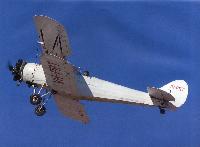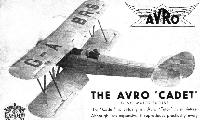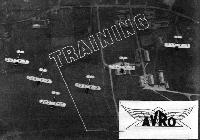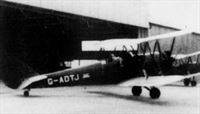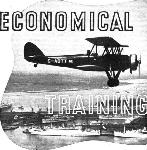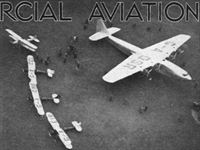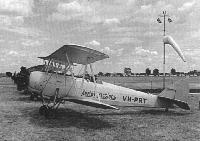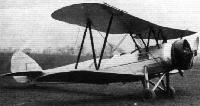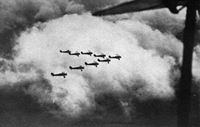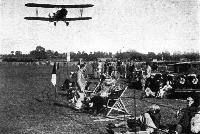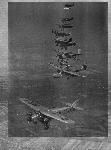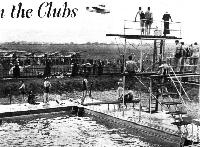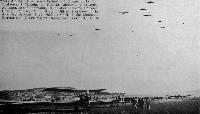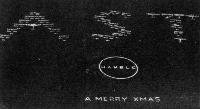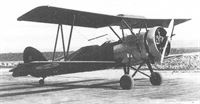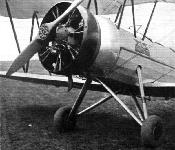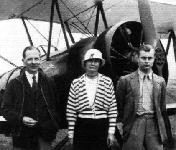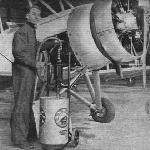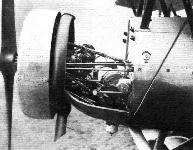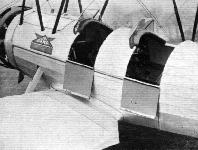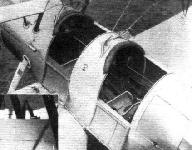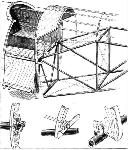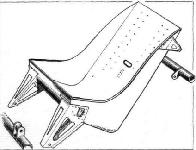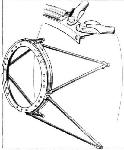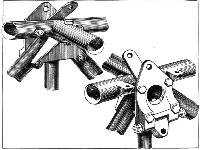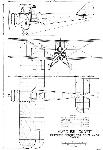
Описание
Страна : Великобритания
Год : 1932
Двухместный самолет первоначального обучения
Варианты
- Avro - Tutor/Sea Tutor/Prefect / Type 621/646/626 - 1929 - Великобритания
- Avro - Cadet / Type 631/643 - 1932 - Великобритания
- Avro - Club Cadet / Type 638/639/640 - 1933 - Великобритания
Avro 631 и Avro 643 Cadet
Разработка самолета Cadet, который представлял собой уменьшенный вариант самолета Tutor, началась в 1931 году. Всего построили 35 аэропланов Avro 631 Cadet для частных заказчиков и авиационного корпуса армии Ирландии. За Avro 631 последовало восемь самолетов Avro 643 Cadet, построенных в 1934 году. Подобно Avro 631, на Avro 643 стоял мотор Genet Major I, но фюзеляж имел более округлое сечение и приподнятое сиденье в задней кабине. Четыре Mk II Cadet построили для частных заказчиков, 20 - для Учебно-тренировочного командования британских ВВС и 34 - для ВВС Австралии. Австралия получила самолеты с ноября 1935 по февраль 1939 года, эти машины отличались измененной топливной системой. 16 австралийских самолетов после Второй мировой воины продали частным лицам. Одну машину, ранее принадлежавшую ВВС Австралии, конвертировали в одноместный сельскохозяйственный самолет со звездообразным двигателем Jacobs R-755 мощностью 220 л.с.
Учебные самолеты британских ВВС получили камуфлированную окраску, но сохранили гражданский регистрационный код, самолеты продолжали использовать в течение некоторого времени и после окончания войны.
ТАКТИКО-ТЕХНИЧЕСКИЕ ХАРАКТЕРИСТИКИ
Avro 643 Mk II Cadet
Тип: двухместный самолет первоначального обучения
Силовая установка: один звездообразный мотор Armstrong Siddeley Genet Major IA мощностью 150 л. с.
Характеристики: максимальная скорость на оптимальной высоте 187 км/ч; крейсерская скорость 161 км/ч; скороподъемность 213 м/мин; практический потолок 3660 м; дальность 523 км
Масса: пустого 583 кг; максимальная взлетная 907 кг
Размеры: размах крыла 9,20 м; длина 7,54 м; высота 2,69 м; площадь крыла 24,34 м2
Описание:
- Avro 631 и Avro 643 Cadet
- Flight, March 1932
The Avro 631 "Cadet" - Flight, July 1933
THE NEW “AVRO-CADET" SERIES - Flight, February 1936
A NEW RECRUIT - Flight, April 1936
MODERN LIGHT AIRCRAFT REVIEWED
Фотографии
-
Aeroplane Monthly 2000-02 / M.Oakey, T.Harmsworth - News
Регистрационный номер: ZK-AVR A rare picture of sole airworthy Avro 631 Cadet ZK-AVR airborne near Auckland during a test flight.
-
Aeroplane Monthly 1986-09 / Avro Type 643 Cadet VH-PRT /Preservation Profile/
Регистрационный номер: VH-PRT [3], A6-20 [3] -
Flight 1932-03 / Flight
Регистрационный номер: G-ABRS [2] -
Flight 1933-09 / Flight Advertisements
Регистрационный номер: G-ABRS [2] The "Cadet" is virtually an Avro "Tutor" in miniature. Although less expensive, it reproduces practically every feature which led to the adoption of the "Tutor" for Royal Air Force Training.
-
Aeroplane Monthly 1982-07 / R.Riding - The 1932 King's Cup air race
Регистрационный номер: G-ABVU The Avro Cadet of Sqn Ldr J. W. Woodhouse
-
Flight 1932-06 / Flight
Регистрационный номер: G-ABVV LUXURY FOR THE PRIVATE OWNER: Major J. E. D. Shaw, who flies at Heston, has recently acquired this Avro "Cadet" (7 cyl. Genet). It has very complete dual controls.
-
Flight 1933-07 / Flight
Регистрационный номер: G-ABYC [3] THE STANDARD "CADET": This forms the prototype of the "Cadet Family," and is characterised by a pronounced stagger of the wings. The engine is a 7-cyl. "Genet Major."
-
Flight 1933-09 / Flight
Регистрационный номер: G-ABYC [3] READY FOR THE START: The five machines lined up at Portsmouth Aerodrome, before starting for the race round the Isle of Wight.
-
Air Enthusiast 1996-05 / R.Bonser - Hamble Pictorial. Air Service Training in the 1930s
Регистрационный номер: G-ABYC [3] AST was formed by Armstrong Whitworth in 1931 with a large hangar built for the flying school on the north airfield (the former Avro factory and flying field being to the south). In this view of the crowded school hangar, the DH.83 Fox Moth G-ACCA helps to date the picture. This was registered in February 1933 but exported to Australia the following September, becoming VH-UTY. Other types in view are the staple of the school, with A W Atlas Trainer G-ABHW (registered April 1931, scrapped in 1938) in the left foreground. Behind the Fox Moth is Avro 621 Tutor G-ABIS which served with AST from March 1931 through to October 1941 as HM505 (by which time the school was designated 3 EFTS), becoming instructional airframe 3064M in April 1942. Behind the Atlas is Avro 631 Cadet G-ABYC which is another interloper, not having served with AST. This machine is the longest survivor of those identifiable in the photo, being broken up at Barton, Manchester in mid-1951.
Другие самолёты на фотографии: Armstrong Whitworth Atlas / Ajax - Великобритания - 1925Avro Tutor/Sea Tutor/Prefect / Type 621/646/626 - Великобритания - 1929De Havilland Fox Moth / D.H.83 - Великобритания - 1932
-
Flight 1933-07 / Flight Advertisements
Регистрационный номер: G-ACCI, G-ACCN Avro Cadet. Genet Major Engine. The qualities essential to the complete flying instruction of war pilots are present in the Cadet to a degree which is unparalleled at such economical initial cost. The Cadet is standard equipment for the training of Royal Air Force Reserve pilots at Air Service Training Limited.
-
Aviation Historian 1 / P.Jarrett - Under the windstocking
Регистрационный номер: G-ACCM [2] The AVRO 631 Cadet was a scaled-down version of the Tutor intended for use by civilian flying clubs or private owners, with wooden wings and control surfaces and a 135 h.p. Armstrong Siddeley Genet Major I engine. This example, G-ACCM, was delivered to Air Service Training Ltd (AST) at hamble, the largest user of the type, in March 1933, but suffered a night crash in the River Thames at Purfleet, Essex, on April 17, 1936. It was apparently later bought by the Far East Aviation School at Hong Kong, an AST associate. Although AST found the Cadet ideal for ab initio instruction, aerobatics and blind flying, it did not fare well on the civil market because it was expensive to run compared with contemporary light two-seaters and its wings could not be folded.
-
Flight 1935-01 / Flight Advertisements
Регистрационный номер: G-ABXU, G-ACCH, G-ACCL [2], G-ACCM [2], G-ACNE, G-ACNF [4] -
Flight 1935-01 / Flight Advertisements
Регистрационный номер: G-ACNF [4] The machines illustrated include a new delivery of "Cadets" to the famous "Air University" of Air Service Training Ltd. This school, which is the only one of its kind in the world, maintains the high standard of its flying instruction by using Avro aeroplanes equipped with Siddeley engines.
-
Flight 1938-08 / Flight
Регистрационный номер: G-ACNF [4], G-ADAV -
Мировая Авиация 40
Регистрационный номер: G-ADFD Данный самолет Avro 643 Cadet эксплуатировался с 1934 года по 1961 год.
-
Flight 1936-02 / Flight
Регистрационный номер: G-ADJT [2] In external appearance the 643 Mk.II resembles the ordinary staggered Cadet. The re-arrangement of the bracing wires is visible in this view.
-
Flight 1936-04 / Flight
Регистрационный номер: G-ADJT [2] The latest addition to the Avro range of trainers - the 643, which replaces the Club and standard Cadets. Certain modifications have been made to improve the machine from the tuitional standpoint, and the airframe has been strengthened.
-
Aeroplane Monthly 1984-05 / N.Hearn-Phillips - Pilot's progress
Регистрационный номер: G-ADTJ My first introduction to flying was in an Avro 643 Cadet with a Genet Major 1A engine of 140 h.p. I had no difficulty in flying the aircraft, but I found it hard to sort out my approaches under different wind conditions. My second instructor soon rectified this, but even so I took a worrying long time to go solo - 17hr!
-
Flight 1936-08 / Flight Advertisements
Регистрационный номер: G-ADTT -
Flight 1938-02 / Flight
Регистрационный номер: G-ACCL [2], G-ACNF [4], G-AEIR Proportion: The first A.W. Ensign, now at Coventry, with a few attendants from the A.S.T. school fleet at Hamble.
Другие самолёты на фотографии: Armstrong Whitworth Ensign / A.W.27 - Великобритания - 1938
-
Aeroplane Monthly 1976-06 / News Spotlight
Регистрационный номер: EI-ALP Avro Type 631 Cadet EI-ALP made its first flight on March 21, 1976, after seven years restoration work by its owner, J. C. O’Loughlin, at Wexford Airfield. It was still awaiting its Certificate of Airworthiness when this picture was taken.
-
Aeroplane Monthly 1986-09 / Avro Type 643 Cadet VH-PRT /Preservation Profile/
Регистрационный номер: VH-PRT [3], A6-20 [3] VH-PRT photographed in the early Sixties.
-
Flight 1932-05 / Flight
A view of the new Avro "Cadet" which Mr. H. A. Brown threw about in an amazing manner. Six of these aircraft have been delivered to the Irish Free State for training.
-
Flight 1932-03 / Flight
THE AVRO 631 "CADET": The front view shows the simple and clean design.
-
Flight 1938-08 / Flight
Very pretty formation: The leading Cadet was flown by one of the instructors, but all the other eight were piloted by members of the squadron.
-
Jane's All the World Aircraft 1938 / 01 - The progress of the world in civil aviation during the year 1937-38
HAMBLE. - AIR SERVICE TRAINING LTD. - An Avro 643 Cadet (160 h.p. Genet-Major 1a) flying over workshops and quarters at Hamble, near Southampton.
-
Flight 1933-09 / Flight
THE "GARDEN" PARTY: An A.S.T. "Cadet" flying over the club enclosure.
-
Flight 1934-05 / Flight
The staggering formation of aircraft was flown by instructors of Air Training Services Ltd in 1934. The aircraft are, from top to bottom: Avro Avian IVM, Avro Cadet, Avro Tutor, D.H.9J, Avro 626, Armstrong Whitworth Siskin III, Armstrong Whitworth Atlas, Saro Cutty Sark and an Avro Five.
Другие самолёты на фотографии: Armstrong Whitworth Atlas / Ajax - Великобритания - 1925Armstrong Whitworth Siskin - Великобритания - 1921Avro Avian / Type 594/616 - Великобритания - 1926Avro Five / Type 619 / Six / Type 624 - Великобритания - 1929Avro Tutor/Sea Tutor/Prefect / Type 621/646/626 - Великобритания - 1929De Havilland D.H.9J - Великобритания - 1926Saunders-Roe Cutty Sark / A.17 - Великобритания - 1929
-
Flight 1933-07 / Flight
A COOL VIEW: Visitors find the high diving board a good grandstand. F/O. Murray flying past in the "Cutty Sark" of A.S.T. The Avro "Cadets" are also from A.S.T.
Другие самолёты на фотографии: Saunders-Roe Cutty Sark / A.17 - Великобритания - 1929
-
Jane's All the World Aircraft 1938 / 01 - The progress of the world in civil aviation during the year 1937-38
The Flying School of The Far East Aviation Company, Ltd., at Hong Kong.
-
Jane's All the World Aircraft 1938 / 02 - The progress of the world in military aviation during the year 1937-38
The Delivery of ten Junkers Bombers to the Air Force at Alverca. Two Avro Training Machines are seen in the foreground.
Другие самолёты на фотографии: Junkers Ju.86 - Германия - 1934
-
Flight 1934-07 / Flight
AVROS AT THE S.B.A.C. DISPLAY: From front to back, the "Cadet," the Autogiro, the "Commodore," the 626, and the 642.
Другие самолёты на фотографии: Avro Commodore / Type 641 - Великобритания - 1934Avro Tutor/Sea Tutor/Prefect / Type 621/646/626 - Великобритания - 1929Avro Type 642 - Великобритания - 1933Cierva/Avro C.30A / Rota - Великобритания - 1932
-
Flight 1932-05 / Flight
The start of the first heat for the Race at Skegness: (Left to right) "Avian," "Cadet," "Avian," "Spartan," "Widgeon" and Autogiro - the last, in its first race.
Другие самолёты на фотографии: Avro Avian / Type 594/616 - Великобритания - 1926Cierva/Avro C.19 - Великобритания - 1929Simmonds Spartan - Великобритания - 1928Westland Widgeon - Великобритания - 1924
-
Flight 1932-07 / Flight
A view out of the hangar at Hamble, showing the "Avians," "Cadets," "Atlases" and "Siskins" used by A.S.T.
Другие самолёты на фотографии: Armstrong Whitworth Atlas / Ajax - Великобритания - 1925Armstrong Whitworth Siskin - Великобритания - 1921Avro Avian / Type 594/616 - Великобритания - 1926
-
Flight 1936-12 / Flight
APPOSITE: Christmas greetings from Air Service Training Ltd. at Hamble. The message is formed by white-overalled humanity "on the hands down," and the "A.S.T." consists of the ten different aircraft types which form the organisation's fleet: Avro V, 626, Avian, Tutors and Cadets; two-seater Siskin; A.W. Atlas; two Cutty Sarks; and D.H. Leopard Moth and Hornet Moth.
Другие самолёты на фотографии: Armstrong Whitworth Atlas / Ajax - Великобритания - 1925Armstrong Whitworth Siskin - Великобритания - 1921Avro Avian / Type 594/616 - Великобритания - 1926Avro Five / Type 619 / Six / Type 624 - Великобритания - 1929Avro Tutor/Sea Tutor/Prefect / Type 621/646/626 - Великобритания - 1929De Havilland Hornet Moth / D.H.87 - Великобритания - 1934De Havilland Leopard Moth / D.H.85 - Великобритания - 1933Saunders-Roe Cutty Sark / A.17 - Великобритания - 1929
-
Aeroplane Monthly 1986-09 / Avro Type 643 Cadet VH-PRT /Preservation Profile/
Регистрационный номер: A6-20 [3], VH-PRT [3] One of A6-32's sisterships, A6-20, seen with a pupil under the hood and with the safety pilot waving both hands in the air.
-
Air Enthusiast 1997-01 / C.Owers - Comparative 'Maggie'
Регистрационный номер: A6-10 The Magister was never expected to be built in Australia but was to introduce the RAAF and CAC to the new type of trainer thought necessary for the emerging high powered service monoplanes then entering service. Avro Cadet Mk II in the background.
Другие самолёты на фотографии: Miles Magister / M.14 - Великобритания - 1937
-
Air Enthusiast 1998-01 / R.Niccoli - Atlantic Sentinels
One Avro 631 Cadet was acquired in 1934 to participate in the evaluation for the new trainer.
-
Flight 1932-03 / Flight
REDUCING AIR DRAG: Behind the Townend ring is the exhaust collector ring, which in turn is separated by a large air space from the hemispherically-shaped nose of the fuselage. Note also the tripod undercarriage.
-
Flight 1932-09 / Flight
Mr. and Mrs. Gardner and their son with his Avro "Cadet." Mr. Gardner is taking an extensive course at A.S.T., Hamble, where his parents also underwent a course of instruction recently.
-
Flight 1934-02 / Flight
EASY TO HANDLE: By means of this wheelbarrow-pump Adcol lubricating oil is now supplied direct from ten gallon drums at most aerodromes. Here, it is filling up one of Airwork's Avro "Cadets" at Heston.
-
Flight 1936-02 / Flight
The grouping of the accessories behind the engine and the ease of access to them for maintenance purposes is visible here. Note the oil cooler.
-
Flight 1932-03 / Flight
EASY ENTRY AND EXIT: By dropping the top longerons of the fuselage, the cockpit doors can be made very deep, and both passengers can readily escape by parachute in case of emergency.
-
Flight 1936-02 / Flight
Ease of exit by parachute is desirable in a training aeroplane and is not lacking in the new Cadet. This view shows also the capacious luggage locker.
-
Aeroplane Monthly 1989-02 / Personal album. Civil
Регистрационный номер: G-ADTY [2] Two photographs of Avro 643 Mk II Cadet taken shortly after an incident at Desford in 1936. G-ADTY was first registered in January 1936 to Air Service Training and based at Ansty. In July 1941 it was impressed into RAF service as an instructional airframe, becoming 2941M, and was delivered to No 437 Sqn ATC at Poplar in London. The Avro 643 Mk II was powered by a 150 h.p. Armstrong Siddeley Genet Major IA. Introduced in September 1934, the 643 was an improved version of the Type 631 and featured thicker wing spars and an inverted fuel system.
-
Aeroplane Monthly 1989-02 / Personal album. Civil
Регистрационный номер: G-ADTY [2] -
Flight 1932-03 / Flight
SOME FUSELAGE DETAILS: Welded steel tube construction is used for the main structure of the fuselage. The top longerons are dropped in the centre portion to give deeper cockpit doors. The secondary structure is of wood, and attached to the primary structure by simple clips.
-
Flight 1932-03 / Flight
SIMPLE SEAT SUPPORTS: No seat bearers are used, the seats being carried on two of the main structure cross tubes in the manner shown.
-
Flight 1932-03 / Flight
EASILY DETACHABLE TOWNEND RING: Brackets fixed on the cylinder heads locate the ring, which is in two halves. On the ring are corresponding brackets, felt pads being interposed between the two brackets. Quick-release catches on opposite sides of the ring diameter can be undone in a few moments, and the two halves of the ring removed from the engine. The two halves of the ring are shown on the right.
-
Flight 1932-03 / Flight
THE ENGINE MOUNTING: The ring supporting the "Genet Major" engine is carried on four steel tube vees, the apices of which pick up the ends of the four longerons. The curved tube on the ring, shown in the inset, locates the cowl-securing cable.
-
Flight 1933-07 / Flight
WHERE THE SHOCK IS TAKEN: The fitting which attaches the undercarriage telescopic leg to the fuselage on the "Cadets."
-
Flight 1932-03 / Flight
Avro 631 "Cadet" Armstrong Siddeley 7-Cyl. Genet Major Engine
-
Flight 1933-07 / Flight
Avro 643 Standard "Cadet" 7 cyl. Genet "Major" Engine
- Фотографии

